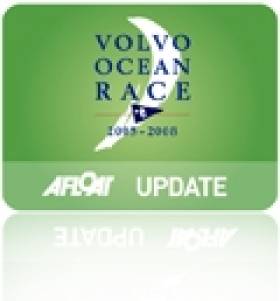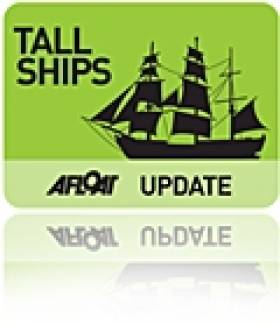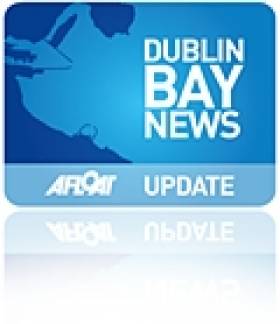Displaying items by tag: Parade of Sail
#VOR – Up to 200 sailing boats – including many traditional sailing craft – will take part in the dramatic "Parade of Sail" which is being staged in conjunction with the Volvo Ocean Race.
The fleet of 6 Volvo ocean racing yachts are now expected in Galway Bay late on Monday night ,July 2nd or early Tuesday morning, July 3rd.
The "Parade of Sail" is the traditional seafaring salute to the crews who have completed an epic ocean voyage. Boats, which are making their way to Galway from many parts of the
country, will join a fleet of local sailing boats and traditional Galway hookers ,currachs and fishing boats
Thirty boats from the Mayo Sailing Club left their base at Rossmoney, near Westport, today and are now on their way to Inishboffin where they will overnight. They will sail to the Aran Island's tomorrow and rendezvous with the parade of sail on Galway Bay.
The dramatic "Parade of Sail" will begin at the Blackrock Mark, off Salthill, at 4.30pm. The parade will be led by "The Green Dragon", Ireland's entry in the 2008-2009 Volvo Ocean Race. Smaller boats will join the parade at the Blackrock Diving Board. The flotilla will then make its way to the Harbour.
Parade of Sail co-ordinator, Pierce Purcell, said the series of events on the Bay on Sunday which will also include the Multihull Catamaran Championships and the traditional Galway Hooker Regatta, will be "the most fantastic turnout of boats ever seen on Galway Bay"
The Parade of Sail Organisers have issued the following instructions to participating boats.
All craft should allow sufficient time to be at the Blackrock Buoy area in time for a 4.30 start.
FLEET A. It is intended to let the powerboat fleet of participating pleasure boats, RIBS fishing boats start first in an orderly fashion spaced out in single file. This fleet will be led by a blue Garda RIB positioned in the middle of the start area at 4.29 pm.
FLEET B. Yachts in descending order size will set sail immediately after the powerboat fleet. This fleet will make its way inshore to Salthill along the Prom and around Mutton Island.
Fleet C. This fleet comprises of craft up to 4 metres, sailboards, currachs, dinghies and canoes will assemble near the diving tower at Salthill for 4.30.
FLEET D. The Galway Hooker Fleet will assemble after the last boat race is finished in the area between Galway Bay Hotel and Seapoint
FlEET E. The Junior Parade of Sail will launch at the Ocean Sports Club at 4.30.
SAIL PAST. 17.00 hours. A suitable yacht dressed overall will be moored off Nimmos Pier to welcome the fleet.
Entry List Announced for Tall Ships Races 2012
#TALL SHIPS - Eighteen vessels are on the entry list for the 2012 Tall Ships Races which are set to conclude in Dublin Port next August.
The list is dominated by British entries, with all nine UK tall ships expected to sail the third and final leg from A Coruña in northern Spain to Dublin.
Tall ships from Russia, Poland, France, Ecuador, Bulgaria, Latvia, Estonia and Belgium will also be in the fray when Ireland's capital hosts the final port of call for the 2012 races, presented by Szczecin in Poland and organised by Sail Training International - a charity established to harness sail training to develop and educate young people regardless of nationality, culture, religion, gender or social background.
The first leg of the 2012 races kicks off in Saint-Malo, France on 7 July with ships racing to Lisbon in Portugal (till 21 July); Cádiz in southern Spain (21-28 July) and A Coruña (28 July-12 August) before the final leg.
Dublin will be hosting the Tall Ships Races for the first time since 1998. Earlier this year Eamonn O’Reilly, CEO of Dublin Port Company, said he was “delighted to welcome the Tall Ships Races to Dublin Port" in 2012.
Since the announcement the port has already played host to the British tall ship Tenacious and the Norwegian vessel S/S Statsraad Lehmkuhl.
From Thursday 23 to Sunday 26 August 2012 as many as 100 ships are expected to arrive in the port and Docklands area for an event that includes a four-day festival programme of music, food and fashion showcases, markets, street theatre, water sport and water-based activities.
The weekend will also feature activities unique to the races including a crew parade, prize-giving event and a parade of sail.
Are you looking to get involved in Dublin's hosting of the Tall Ships Races? Check out the following links:
Become a trainee www.dublintallships.ie/trainees/
Take part as a volunteer www.dublintallships.ie/volunteers/
For further information see www.dublintallships.ie or e-mail [email protected]
Entry List for the Tall Ships Races 2012:
Akela (Russia)
Black Diamond Of Durham (UK)
Dar Mlodziezy (Poland)
Etoile Polaire (France)
Guayas (Ecuador)
Johanna Lucretia (UK)
John Laing (UK)
Kaliakra (Bulgaria)
Lord Nelson (UK)
Maybe (UK)
Moosk (UK)
Pelican Of London (UK)
Pogoria (Poland)
Rona II (UK)
Spaniel (Latvia)
St Iv (Estonia)
Thermopylae Clipper (UK)
Tomidi (Belgium)
Container Ship Successfully Refloated in Waterford Harbour
In attendance was Bargarth, a UK-flagged tug based in Waterford and operated by Fastnet Shipping. The twin Voith & fire-fighting tug made a special appearance during the Tall Ships Races Parade of Sail on 3 July, when she put on a celebratory water-display off Dunmore East.
Samskip Eandeavour is capable of handling 812 twenty-foot equivalent containers (TEU). She was completed only this year by Damen Gorinchem Scheepswerf B.V. Foxtol in the Netherlands. The vessel is operated by an Icelandic company, Samskip which provides several container feeder-liner services between Rotterdam / Zeebrugge with Belfast, Dublin, Cork and Waterford.
After unloading and loading at Belview the 140m vessel is scheduled to dock in the Port of Cork tomorrow at the Tivoli Container Terminal before returning to Europe.
Tall Ships Parade of Sail Photos 2
More of Gary O'Mahony's images of the Tall Ships fleet leaving Waterford.
Lord Mayor to Preside over Old Gaffers' Parade of Sail
Dublin's Lord Mayor Gerry Breen will assume the traditional title of Admiral of the Port of Dublin when he presides over the Parade of Sail on the Liffey later this month.
The parade on Sunday 29 May is a highlight of the annual Dublin Bay Old Gaffers Association rally, which this year is held in tandem with the Stella Maris Rowing Club regatta.
Rowing clubs along the east coast will be sending crews to Dublin to compete for the special Asgard Trophy, which is made of timber used in the conservation of the original Asgard in the National Museum.
The event - centred at the Poolbeg Yacht and Boat Club near Ringsend - is also expected to attract classic vessels from ports in Wales and Northern Ireland.
For more information contact the Dublin Bay Old Gaffers Association at www.dublinbayoldgaffersassociation.com or [email protected]
The Old Gaffers Association is a sailing organisation dedicated to preserving traditional sailing craft, usually former working boats, and mainly of wooden construction, promoting their distinctive gaff rig.
The Return of the 'Wexford' Tall-Ship
A grant of €1m from Fáilte Ireland was allocated towards the cost of the refit as part of the National Development Plan (NDP). Visitors can now take guided tours of the floating tourist attraction though access to the shoreside visitor centre remains closed due to an upgrade. Work on an extension of a new exhibition centre is expected to be completed in May or June.
Dunbrody is a full scale reconstruction of the 19th century replica famine-ship based on the vessel built in 1845 in Quebec, Canada for the Graves family of New Ross. Ireland's most inland port being made famous with the visit of President John F. Kennedy in 1963 to the same quayside where Dunbrody is berthed.
To date the Dunbrody's presence outside her homeport has been scarce. During the Waterford Tall Ships Festival in 2005 she took part in a memorable and historic 'Parade of Sail' where she formed as part of the trio of Irish tall ships that met together for the only time. The sailing spectacle of the international fleet was headed firstly by the Irish trio with Asgard II leading followed by Dunbrody and astern the Jeanie Johnston.
In the following year Dunbrody made her maiden and only international voyage to Milford Haven in south Wales. The Pembrokeshire estuary had hosted the new festival, Seafair Haven. On that occasion she had the honour of leading another parade of sail, under the command of Captain Tom McCarthy.
Dunbrody was last dry-docked in 2006 and also at the New Ross boatyard which lies on the Co. Kilkenny side of the riverbank. The 176 foot / 54 metre barque was built in 2001 and was last vessel completed at the boatyard. During her building the public could access the yard and the construction process could be viewed from above at a gallery set within the covered building hall.
The structure no longer exists but which was built originally for the Ross Company boatyard during the 1970's. The yard specialised in building barge pontoons for markets in the North Sea until the premises closed in the 1980's. In recent years and under new management the dry-dock (75m X 15m) has been upgraded with a new gate and pump.
Looking for further reading on Tall Ships in Ireland? Click the links below:
Click this link to read all our Tall Ships Stories on one handy page
Previewing Ireland's Tall Ships 2011 Season
Can Ireland Get a New Tall Ship?
- Asgard II
- Jeanie Johnston
- river barrow
- New Ross
- River Suir
- Milford Haven
- Ports and Shipping News
- barque
- Fáilte Ireland
- Dunbrody
- Parade of Sail
- Brigantine
- Waterford Tall Ships Festival
- Dunbrody Heritage Centre
- River Nore
- New Ross Boat Yard
- Sea Haven
- National Development Plan
- NDP
- President John F. Kennedy
- Capt. Tom McCarthy
- Ross Company
- Seafair Haven
'Ferry' to Headline Waterford Tall Ships
Looking ahead to the Waterford show, Bryan Ferry said,' I am delighted to be returning to perform in Ireland following Roxy Music's performance at
Electric Picnic last year'.
Ferry will perform on the festival's main stage at Bolton Street. On the same site of the following night, The Waterboys will be supported by Waterford's O Emperor. While on the 2 July the headline act will be the Sharon Shannon Show with special guests Damien Dempsey and Dessie O'Halloran.
The four-day maritime spectacle which runs to 3 July is set to host over 70 tallships, over 1,500 trainee sailors and an anticipated 500,000 visitors that are to throng the 'Noblest Quays in Europe' with the countdown to the festival edging closer to just 100 days.
Billed as the largest Irish festival event in 2011, the return of the Tall Ships for the second time to Ireland's oldest city, presents young Irish people to experience a once in a lifetime opportunity to set sail onboard a tall-ship.
The opportunity is open to those aged 16 or over by June 30, 2011 and are fit and active to be a trainee on the inaugural race leg from Waterford to Greenock (departing 3 July). For further information click here.
The festival is not just eagerly awaited by fans of all things maritime and musical but with a programme that is also to feature street theatre, culinary and craftwork 'villages' and firework displays.
Renowned street theatre company 'Spraoi' have commissioned almost 20 national and international street performance acts. In addition the award-winning illusionist, Keith Barry will perform another specially-commissioned piece at the launch on the afternoon of 30 June.
On the nautical front, highlights include the 'Crew Parade' on 1 July and ultimately culminating with the 'Parade of Sail' by the international fleet on 3 July. Asides the city quayside on the River Suir the Waterford estuary provides excellent viewing points, some at elevated sites.
Looking for further reading on Tall Ships in Ireland? Click the links below:
Click this link to read all our Tall Ships Stories on one handy page
Previewing Ireland's Tall Ships 2011 Season
Can Ireland Get a New Tall Ship?
- street theatre
- Waterford Estuary
- River Suir
- Ports and Shipping News
- The Waterboys
- Keith Barry
- Bryan Ferry
- Roxy Music
- Waterford Tall Ships Race Festival
- TallShips
- Electic Picnic
- Sharron Shannon
- Spraoi
- Crew Parade
- Parade of Sail
- SailTrainees
- Damien Dempsey
- Dessie O'Halloran
- Noblest Quays in Europe
- RaceLeg
- WaterfordGreenock


































































